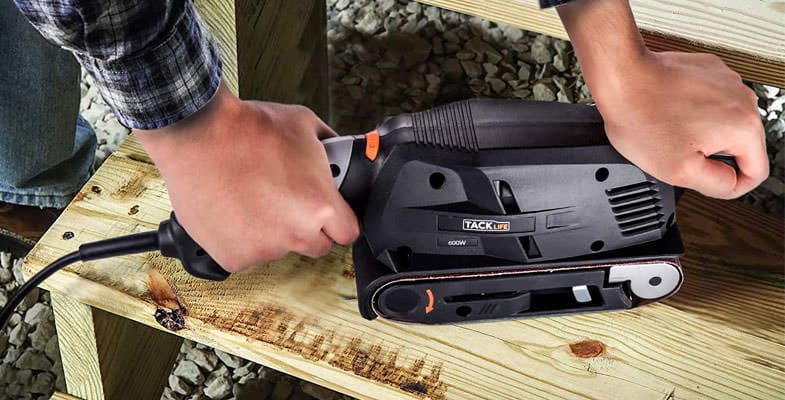The Best Belt Sanders for Sanding and Polishing
Here are the best belt sanders for sanding and polishing wood, metal, and other surfaces and how to choose the best one according to the type of work.
The belt sander allows us to work on all wooden objects, such as boards, doors, tables, metal, plastic, concrete, or ceramic.
It works using a rotating belt on which special abrasive belts of different grains are mounted depending on the final result: smoothing, polishing, and finishing.
You can use the belt sander in two ways. The earliest and most common consists of holding it firmly with the hands by the appropriate handles and sliding the tape directly on the object to be sanded, a method used for large surfaces.
The second is that the sander is turned upside down and fixed on the counter so the belt can slide freely. In this case, the object will be brought closer to the abrasive paper on the belt to be smoothed.
Table of Contents
How to choose a belt sander: Types and Characteristics
To understand how to choose the belt sander that best suits our needs, let’s see the main features to consider when buying.
Power
As for the power of belt sanders to be used at home, we can find a wide choice of models between 500 and 1200 watts. Based on the work we have to do, we can rely on a more or less powerful sander. Taking into account that more power translates into a heavier engine.
The sander’s higher power usually corresponds to a higher speed intended as the maximum achievable speed. But, again, the choice is to be made based on the use we will have to make of it.
Adjustable speed
Even with a powerful sander, we can adjust our liking speed according to the result we want to achieve. For more delicate materials or finishing work, it is advisable to decrease the belt’s speed to control it.
Most sanders today allow you to adjust the speed expressed in revolutions per minute; in this regard, we find different speed levels between 200 and 450 revolutions per minute.
The more we rely on a quality sander, the more we can adjust the speed, for example, up to 6 levels, while the long-standing sanders allow two or three-speed levels, sometimes only one.
Dimensions and Weight
Dimensions and weight of the belt sander certainly influence maneuverability. Today, most models are compact to reduce the overall dimensions to a minimum; we find sanders weighing between 7 and 13 lbs.
In addition to the size, we consider the smoothing surface’s size and the part of the abrasive belt that will contact the materials and determine the real size that the sander allows us to work. So, for example, we can find sanders that mount a 75 mm x 533 mm sanding belt with a 75 × 140 mm smoothing surface.
Handle
The handle of the sander is essential for effective and safe work. A good belt sander will have two handles on the ends. Usually, the handle on the back of the sander is shaped like a handle, under which there are also the on and off buttons.
On the front, there is a knob-shaped handle. The two-handed handle allows maximum control over the tool and less fatigue. The idea is that the handles are ergonomic and non-slip, both for operator comfort and to guarantee the work’s quality.
Dust collection system
The dust collection system is the default in all sanders, even the cheapest ones. Unfortunately, the sanding job produces many slags, especially on wood, which are harmful if you breathe and can hinder the work area and force us to stop cleaning.
The integrated dust collection system ejects the residues from a tube facing the back of the sander. A dust collection bag, supplied with most models, can be hung on it. Also, some types of sander allow connection to the vacuum cleaner.
Abrasive belt
The abrasive belt is available with different grain types, chosen according to the sanding degree you want.
The grain is marked with a number, where the lower numbers indicate a coarse grain and the higher numbers a thin grain. For example, we will choose 80 grit for roughing the wood and 100 for finishing. The belts are made with abrasive paper or fabric; the latter are more resistant and long-lasting.
To choose the belt, check the measurements indicated by the sander manufacturer. Now abrasive belts are available and interchangeable between the different brands. Instead, what can help choose the best belt sander is a valid replacement system?
Those not used to this type of tool will find levers and clips that hook the tape in seconds and hold it in place without making mistakes.
Carrying case
A good belt sander will be equipped with a special plastic case. The case is handy for transporting the sander and keeping it away from dust and humidity.
The best belt sanders to buy
Below is the complete list of the best belt sanders selected with their respective technical characteristics and prices.
Product prices and availability are subject to change. Therefore, any price and availability information displayed on Amazon at the time of purchase will apply to purchasing any products.

